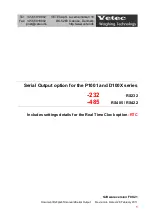
Technical data
80
Automation PC 3100 User's manual V 1.00
Translation of the original documentation
2.3.5.4.3.1 Pinout
CAN bus
Type
Electrically isolated
Transfer rate
Max. 1 Mbit/s
Bus length
Max. 1000 meters
Pin
Pinout
1
n.c.
2
CAN LOW
3
GND
4
n.c.
5
n.c.
6
Reserved
7
CAN HIGH
8
n.c.
9
n.c.
DSUB, 9-pin, male
5
1
9
6
Table 88: 5AC901.ICAN-01 - Pinout
2.3.5.4.3.2 I/O address and IRQ
Resource
Default setting
Function
384h (address register)
Defines the register number to be accessed.
I/O address
385h (data register)
Access to the register defined in the address register.
IRQ
IRQ10
Interrupt
Table 89: I/O address and IRQ
1)
Resource allocation is identical for the interface option 1 and 2 slots.
2.3.5.4.3.3 CAN - Bus length and cable type
The type of cable to be used depends largely on the required bus length and number of nodes. The bus length is
determined by the transfer rate. According to CAN in Automation (CiA), the maximum bus length is 1000 meters.
The following bus lengths are permitted at a maximum permissible oscillator tolerance of 0.121%:
Extension
Transfer rate
≤1000 m
Typ. 50 kbit/s
≤200 m
Typ. 250 kbit/s
≤100 m
Typ. 500 kbit/s
≤20 m
Typ. 1 Mbit/s
Table 90: CAN - Bus length and transfer rate
Preferably, the cable material used should have the following properties or deviate only slightly from them in order
to achieve an optimal transfer rate.
CAN cable
Property
Signal line
Cable cross section
Wire insulation
Conductor resistance
Stranding
Shield
2x 0.25 mm² (24AWG/19), tinned copper stranded wire
PE
≤82 Ω/km
Wires stranded in pairs
Pair shielding with aluminum foil
Ground conductor
Cable cross section
Wire insulation
Conductor resistance
1x 0.34 mm² (22AWG/19), tinned copper stranded wire
PE
≤59 Ω/km
Outer jacket
Material
Properties
Cable shield
PUR compound
Halogen-free
Composed of tinned copper wires
Table 91: CAN cable requirements
StockCheck.com
















































